Leica 28 mm lenses for rangefinder cameras, part 1
The number 2, in its various incarnations, has a wide use in photography. The amount of light that is being transmitted by the aperture or shutter speed doubles or halves with every step. The aperture numbers themselves increase or decrease by a factor 1.4 which is the square root of 2. Every aperture stop has an increment or decrement by 40%. The various lenses have a focal length that also follows the factor 1.4. Starting with a 50 mm lens as the reference value, the range would be 50 mm, 35 mm, 25 mm, 18 mm. The only lens range that follows this pattern was the one for the Zeiss Contarex camera, with lenses of focal length 50, 35, 25 and 18 mm. Leica is close with focal lengths 50, 35, 24, 18 mm. In this case the horizontal viewing angle would be: 39, 52, 74 and 90 degrees. Such a range would make sense, because the change in viewing angle would be substantial and justifies a change of lens. Because most negatives and (now) image files are enlarged to the same size and are observed for the same viewing distance (irrespective of focal length) there is also a change in virtual perspective. The size of foreground objects, relative to the size of the background objects and the distance between foreground and background objects become important compositional elements. There would be no logical reason to fill in ‘gaps’ between these steps in focal length. The 28 mm and the 21 mm are in a sense compromises. The 35 mm focal length was quite easily added to the 50 mm as a universal wide angle when Leitz decided to introduce cameras with interchangeable lenses. A wider angle of view was optically problematic and 28 mm was the next stage. Almost at the same time Leitz adopted the Schneider Angulon lens with a focal length of 21 mm. This very symmetrical design was a scaled down version of the large format lenses. Its heavy vignetting at wider apertures was a problem when used with color slide films.
28 mm
The 28 mm focal length sits between the 35 and 24 mm lenses and could in fact replace both these lenses. For many Leica photographers the choice would be 28 mm, 50 mm to cover the ‘normal’ and wide angle views. Until recently, the iconic Summilux 35 mm ASPH would be the prestige high speed wide angle lens for available light (a rather curious term, because all light is ‘available’) handheld photography. Now the Summilux-M 1:1.4/28 mm ASPH is a serious competitor with a more flexible and universal use.
Below the old Summaron design
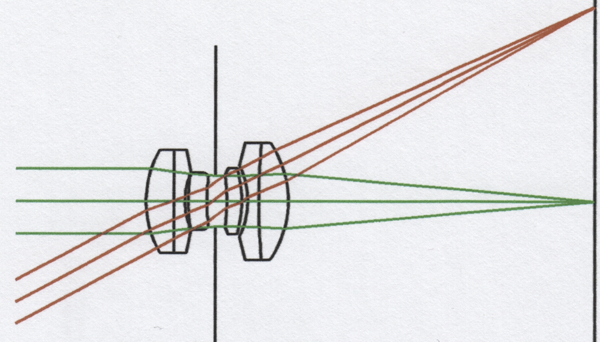
Below the new Summaron-M design

Below the Elmarit-M

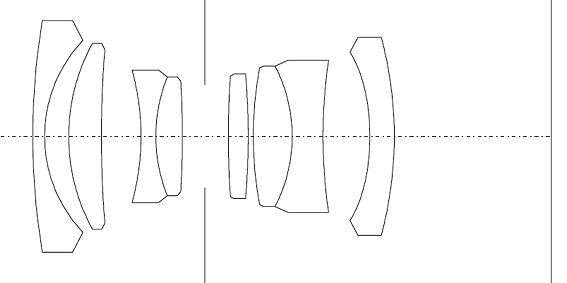
Below the Summilux-M 28 mm

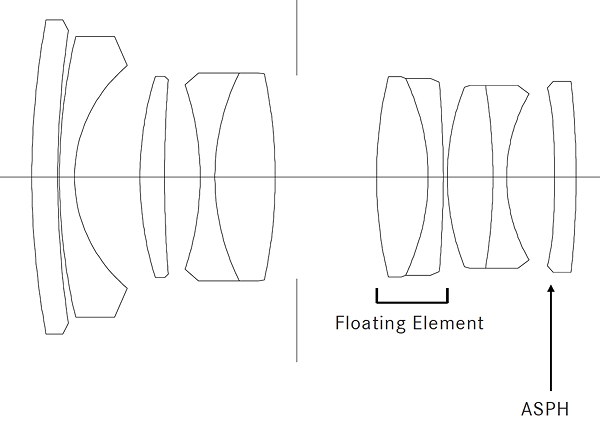
/
The SX 28 mm is one of most modern of Leica lenses and is now accompanied by a truly vintage lens, the Summaron-M 1:5.6/28 mm. The physical layout of this lens is identical with the original and even the choice of material emulates the feeling of the vintage version. The only cosmetic change is the designation which now gives the focal length in millimeters and not in centimeters as the classical version (Summaron f=2.8 cm 1:5.6). The optical prescription follows the classical version quite well. New glasses have replaced the older ones and this has brought a small change in the radii of the surfaces, but all in all, the performance of the lens may be described as vintage. For modern eyes the aperture of f/5.6 is modest, but in 1955 it was quite acceptable and a focal length of 28 mm was a must for many reportage photographers. The 28 mm allows the photographer to be close to the main object and still capture enough of the surroundings to tell a story with one picture. The negative aspect is the danger that the wide viewing angle captures too much and will produce a very untidy composition. This lens separates the amateur from the professional, unless one uses the lens only for (urban) landscapes.
The Summaron-M lens is extremely compact and has the infinity lock. This lock is needed when one needs to attach or detach the lens, but is a bit cumbersome when focusing because then the lens snaps into the lock position inadvertently. This is the reason why this mechanism was gradually phased out on all Leica lenses. The other extreme is the SX 28. This is a lens with a much larger volume, It handles very well with smooth controls and lens plus body have a good balance. The Elmarit-M 28 is one of the smallest modern Leica M lenses. The volume (length times square radius times pi) of the three lenses is as follows: 65 cubic cm, 104 cubic cm and 196 cubic cm. These values are a bit deceptive because the diameter of the mount is not related to the maximum diameter of the optical cell, but to the handling ergonomics. The length of the lens from bayonet to front rim is a good indicator: 18 mm, 31 mm, 67 mm. The weight of the three lenses is: 165 grams, 175 grams and 440 grams. It is surprising that the Summaron subjectively feels heavier than the Elmarit.
Performance as measured: MTF graphs.
The original Summaron was derived from the standard Double-Gauss design and had relatively large diameters of the front and back elements to battle vignetting. Even so, the lens has substantial vignetting of 20% at f/5.6 and 50% at f/16. Remember that in the era of film emulsions a fall-off of 50% represented a half stop and this could easily be corrected in the darkroom. The current Summaron has the same amount of vignetting (not surprisingly because the optical design and the mount are identical), but on a digital camera the vignetting might be reduced. We will see.
Below the MTF of the Summaron-old

/
The MTF of the original Summaron presents the classical solution for a rangefinder lens: very high central definition and a steep drop after the 12 -15 mm image height. Remember too that an image height of 12 mm equals the vertical negative size. Stopping down produces a more even balance between center and edges: the edges improve and the center contrast is lower. The designers of the original Summaron controlled astigmatism very well in the central disc of 9 mm radius and then focused on the sagittal plane, leaving the tangential plane alone. This is a logical choice because the somewhat diffused vertical line pattern is less disturbing visually than the diffused horizontal line pattern. This choice also helps to reduce distortion which is indeed almost zero.
The new vintage Summaron-M lens follows the same MTF pattern, but the values for the tangential plane are higher.
Below the MTF of the new Summaron-M
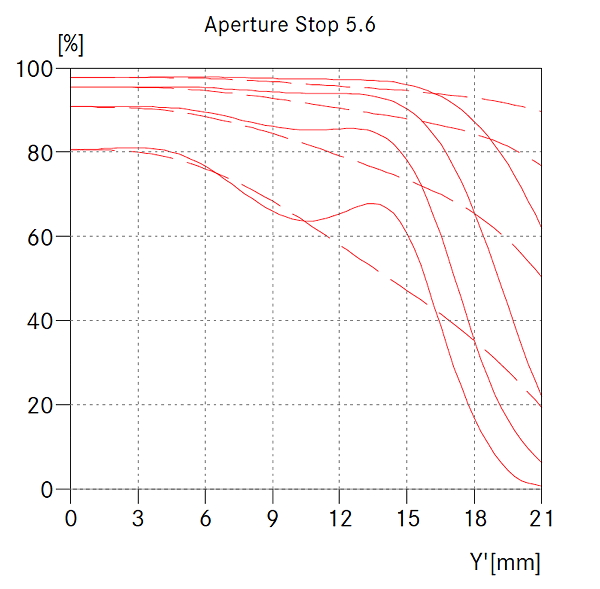
/
The Elmarit-M 28 mm has an aspherical surface and an optical prescription that departs from the symmetrical design and follows the now standard retrofocus design for Leica wide angle lenses. At f/5.6 the performance is very commendable: the line of the 40 lp/mm hovers around the 80% from center to an image height of 9 mm and the performance fall-off, so prominently visible in the Summaron design, is now corrected to a large degree. At f/2.8 the subject outlines are crisply rendered and the textural details are reproduced with high contrast. Given the physical compact size, aperture and angle of view this lens is very well balanced in its performance.
Below the MTF of the Elmarit-M 28mm

/
The Summilux-M 28 mm is proof that a larger size and more degrees of freedom in the optical sense can deliver high quality imagery even at very high speed. At f/5.6 and at f/2.8 the performance emulates the one delivered by the Elmarit-M. The performance at f/1.4 is (by the nature of things) lower with an excellent on axis imagery and a central disc over an area of image height 9 mm that does not drop below 40% for the 40 lp/mm criterion.
Below the MTF of the Summilux-M 28 mm
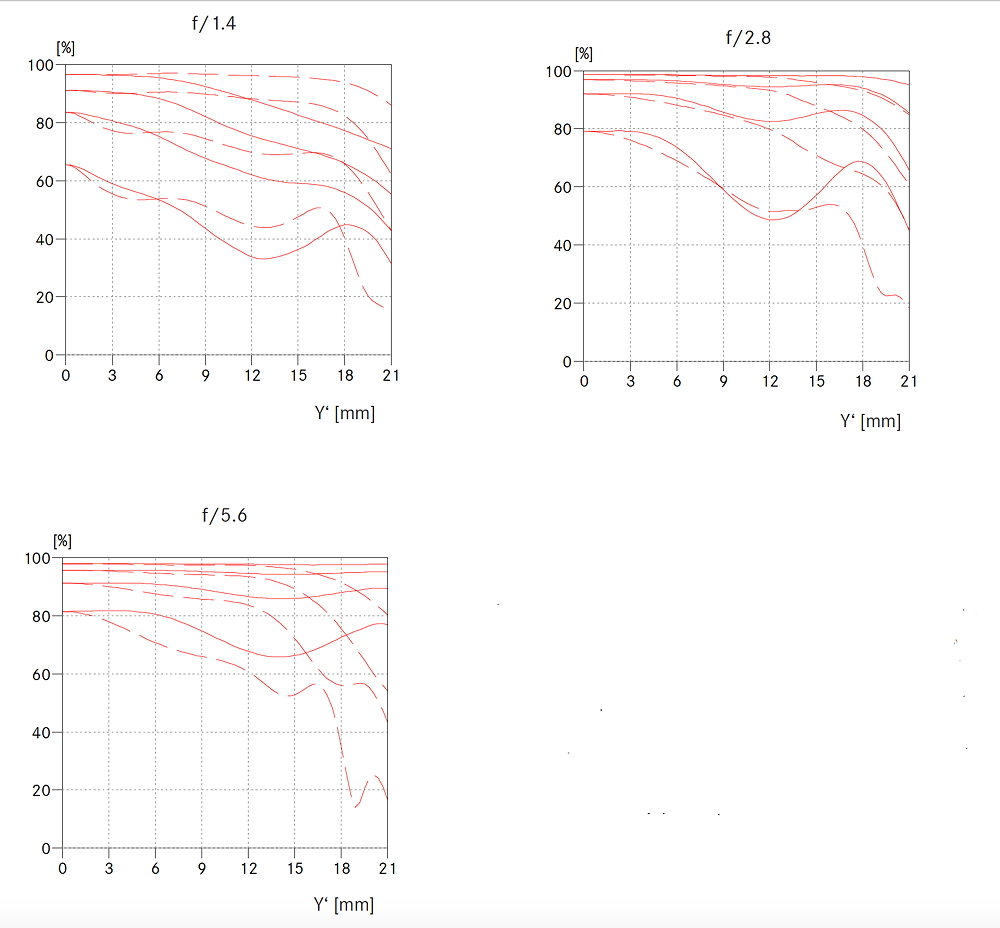
/
Assuming that such a lens will be used handheld in low intensity ambient light (also known as available light) the rendition of very fine detail will be of limited need and value. The Leica rangefinder approach has always set the priority on the focus on the central area because that is where the focus patch will place the plane of sharp focus. The edges of the field are for most picture situations less important. The standard remark by many reviewers who note a difference in image quality between center and edge is in many cases non-informational. Almost every lens shows this behavior and it depends on the application for the lens and the seriousness of the difference (in combination!) whether the choice for a lens is justified. Leica users are a bit spoilt with the number of lenses in the scuderia and the choices.
See the next part.











